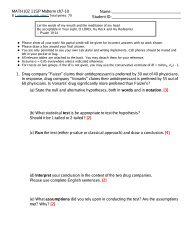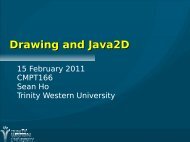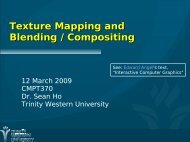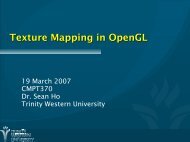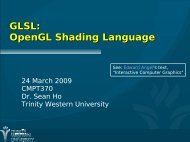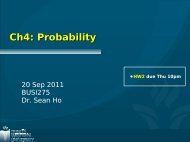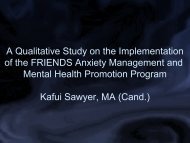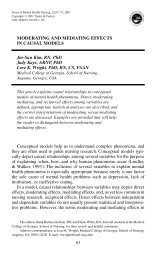Moderators and Mediators
Moderators and Mediators
Moderators and Mediators
You also want an ePaper? Increase the reach of your titles
YUMPU automatically turns print PDFs into web optimized ePapers that Google loves.
<strong>Moderators</strong> <strong>and</strong> <strong>Mediators</strong><br />
14 Oct 2011<br />
CPSY 501<br />
Dr. Sean Ho<br />
Trinity Western University<br />
Please download:<br />
● Peattie2.sav<br />
● ExamAnxiety.sav
Outline for today<br />
<strong>Moderators</strong><br />
● Assessment: test if we have moderation<br />
● Interpretation<br />
● Example: Peattie marital satisfaction dataset<br />
<strong>Mediators</strong><br />
● Assessment<br />
● Example: Exam Anxiety toy dataset<br />
● Interpretation<br />
● MacArthur model<br />
Journal article: Missirlian, et al.: Regression<br />
CPSY501: moderators <strong>and</strong> mediators 14 Oct 2011<br />
2
<strong>Moderators</strong> in Regression<br />
Definition: A moderator is a variable that<br />
interacts with the predictors <strong>and</strong> the outcome,<br />
changing the degree or direction of relationship<br />
Predictor<br />
e.g., confrontational<br />
counsellor intervention<br />
Outcome<br />
e.g., client<br />
outcome<br />
Moderator<br />
e.g., working alliance<br />
CPSY501: moderators <strong>and</strong> mediators 14 Oct 2011<br />
3
Effect of moderation<br />
Does the level of working alliance moderate the<br />
effect of confrontational counsellor intervention<br />
on client outcome?<br />
Better<br />
Client Outcome<br />
Worse<br />
Low<br />
Buffering (moderating)<br />
effect of WAI<br />
Confrontational intervention<br />
High<br />
High WAI<br />
Medium WAI<br />
Low WAI<br />
CPSY501: moderators <strong>and</strong> mediators 14 Oct 2011<br />
4
Asking good RQs<br />
RQ1: Does working alliance moderate client<br />
outcome?<br />
● No good: moderation requires at least three<br />
variables: IV, DV, <strong>and</strong> Mod<br />
RQ2: Does working alliance moderate the<br />
relationship between confrontational<br />
intervention <strong>and</strong> client outcome?<br />
● IV: confrontational intervention<br />
● DV: client outcome<br />
● Mod: working alliance<br />
CPSY501: moderators <strong>and</strong> mediators 14 Oct 2011<br />
5
Regression vs. ANOVA<br />
We can test for moderation in either a<br />
regression or ANOVA model:<br />
Regression: scale-level IV <strong>and</strong> Mod<br />
ANOVA: categorical IV <strong>and</strong> Mod<br />
Remember that regression <strong>and</strong> ANOVA are<br />
really two sides of the same coin: both are<br />
general linear model<br />
Today we'll focus on moderators in regression<br />
● Assume IV, Mod, <strong>and</strong> DV are all scale-level<br />
CPSY501: moderators <strong>and</strong> mediators 14 Oct 2011<br />
6
Testing for Moderation<br />
Centre the predictor <strong>and</strong> moderator:<br />
● Compute: IV – (IV mean) → IV_ctr<br />
Create the interaction term:<br />
● Compute: IV_ctr * Mod_ctr → IVxMod<br />
Run regression model:<br />
● Centred predictor <strong>and</strong> centred moderator go<br />
in blocks in normal order<br />
● Interaction term goes in a subsequent block<br />
If the interaction term is significant, you have a<br />
moderator (common in CPSY research!)<br />
CPSY501: moderators <strong>and</strong> mediators 14 Oct 2011<br />
7
Interpreting <strong>Moderators</strong><br />
If we have moderation, the main effects (effects<br />
of each variable by itself) must be reinterpreted<br />
The presence of a moderating effect indicates<br />
that the relationship between the predictor <strong>and</strong><br />
the outcome variable is different for different<br />
kinds of people (as defined by the moderator)<br />
Theory is needed to determine how to interpret<br />
the interactions.<br />
Analytically, we need to graph the interaction to<br />
underst<strong>and</strong> what is going on.<br />
CPSY501: moderators <strong>and</strong> mediators 14 Oct 2011<br />
8
Example: Peattie, 2004<br />
Birgitte Peattie’s thesis<br />
on marriage, stress, & sanctification.<br />
● Dataset: Peattie2.sav<br />
RQ: Do joint religious activities buffer the effect<br />
of negative life events on marital satisfaction?<br />
● DV: Marital Satisfaction (Mar_sat)<br />
● IV: Negative Life Events (NLE, stress)<br />
● Mod: Joint Religious Activities (JRA)<br />
Buffering: high levels of a “buffer” weaken the<br />
impact of stress<br />
● → interaction!<br />
CPSY501: moderators <strong>and</strong> mediators 14 Oct 2011<br />
9
Preparing Variables<br />
(1) Centre predictor (NLE)<br />
● First calculate the mean: Analyze → Descrip.<br />
● Transform → Compute: NLE – 5.1250<br />
Target Variable: NLE_ctr<br />
(2) Centre moderator (JRA) (but don't centre DV!)<br />
(3) Create interaction term<br />
● Multiply centred predictor <strong>and</strong> moderator:<br />
● Transform → Compute: NLE_ctr * JRA_ctr<br />
Target Variable: NLE_x_JRA<br />
CPSY501: moderators <strong>and</strong> mediators 14 Oct 2011<br />
10
Testing Moderation in Regr.<br />
Analyze → Regression → Linear:<br />
Dependent: Mar_sat<br />
● Block 1: centred predictors: NLE_ctr<br />
● Block 2: centred moderators: JRA_ctr<br />
● Block 3: Interaction term(s): NLE_x_JRA<br />
Statistics: R 2 change, Part/Partial, Collinearity,<br />
Durbin-Watson<br />
Save: St<strong>and</strong>ardized Resid., Cook's, Leverage<br />
Plots: ZPRED vs. ZRESID, ZPRED vs. SRESID<br />
CPSY501: moderators <strong>and</strong> mediators 14 Oct 2011<br />
11
Peattie Data: Model Summary<br />
If the interaction term is significant,<br />
we have moderation<br />
Model Summary d<br />
Std.<br />
Change Statistics<br />
Adjuste<br />
Error of<br />
the R F<br />
d R Estimat Square Chang<br />
Sig. F<br />
Model R R Square Square e Change e df1 df2 Change<br />
1<br />
.335 a .112 .1041.39996 .112 13.911 1 110 .000<br />
2<br />
3<br />
.350 b .122 .1061.39834 .010 1.256 1 109 .265<br />
.391 c .153 .1301.37987 .031 3.937 1 108 .050<br />
a. Predictors: (Constant), NLE_Cent<br />
b. Predictors: (Constant), NLE_Cent, JRA_Cent<br />
c. Predictors: (Constant), NLE_Cent, JRA_Cent, NLE_JRA_Int<br />
d. Dependent Variable: Marital Satisfaction<br />
CPSY501: moderators <strong>and</strong> mediators 14 Oct 2011<br />
12
Peattie: Coefficients Table<br />
Coefficients a<br />
Unst<strong>and</strong>ardized Coefficients<br />
St<strong>and</strong>ardi<br />
zed<br />
Coefficien<br />
ts<br />
Model<br />
B Std. Error Beta t Sig.<br />
1 (Constant) 5.601 .132 42.338 .000<br />
NLE_Cent -.120 .032 -.335 -3.730 .000<br />
2 (Constant) 5.600 .132 42.385 .000<br />
NLE_Cent -.108 .034 -.302 -3.195 .002<br />
JRA_Cent .105 .093 .106 1.121 .265<br />
3 (Constant) 5.672 .135 41.925 .000<br />
NLE_Cent -.081 .036 -.224 -2.220 .028<br />
JRA_Cent .088 .092 .089 .952 .343<br />
NLE_JRA_Int<br />
.037 .019 .195 1.984 .050<br />
a. Dependent Variable: CPSY501: Marital Satisfaction moderators <strong>and</strong> mediators 14 Oct 2011<br />
13
ModGraph: Moderation Tool<br />
Paul Jose’s ModGraph tool:<br />
● Helps us visualize the moderating<br />
relationship: how the PV predicts the DV<br />
depending on the level of the Mod<br />
Jose, P.E. (2008). ModGraph-I: A programme to compute<br />
cell means for the graphical display of moderational<br />
analyses: The internet version, Version 2.0. Victoria<br />
University of Wellington, Wellington, New Zeal<strong>and</strong>.<br />
http://www.victoria.ac.nz/psyc/paul-josefiles/modgraph/modgraph.php<br />
CPSY501: moderators <strong>and</strong> mediators 14 Oct 2011<br />
14
Peattie: Using ModGraph<br />
Select “Continuous Moderator”: Data Entry<br />
Chart Labels:<br />
● Title: “Peattie (2004)”<br />
● X-axis (IV): “Negative Life Events”<br />
● Y-axis (DV): “Marital Satisfaction”<br />
● Moderator: “Joint Religious Activities”<br />
CPSY501: moderators <strong>and</strong> mediators 14 Oct 2011<br />
15
ModGraph: Data Entry<br />
All B values (unst<strong>and</strong>ardized slopes) should<br />
come from the full (last) regression model!<br />
Main effect:<br />
● B=-.081, mean=0 (centred), SD=4.1157<br />
Moderating:<br />
● B=.088, mean=0 (centred), SD=1.4979<br />
Interaction term <strong>and</strong> constant:<br />
● B=.037<br />
● Constant: 5.672<br />
CPSY501: moderators <strong>and</strong> mediators 14 Oct 2011<br />
16
ModGraph: Results<br />
CPSY501: moderators <strong>and</strong> mediators 14 Oct 2011<br />
17
Interpreting Interactions<br />
Slope of IV regression lines differs<br />
for various levels of the moderating variable<br />
Peattie study example:<br />
● In general, negative life events have a<br />
negative impact on marital satisfaction,<br />
● However, joint religious activities weaken<br />
this negative relationship<br />
CPSY501: moderators <strong>and</strong> mediators 14 Oct 2011<br />
18
Outline for today<br />
<strong>Moderators</strong><br />
● Assessment: test if we have moderation<br />
● Interpretation<br />
● Example: Peattie marital satisfaction dataset<br />
<strong>Mediators</strong><br />
● Assessment<br />
● Example: Exam Anxiety<br />
● Interpretation<br />
● MacArthur model<br />
Journal article: Missirlian, et al.: Regression<br />
CPSY501: moderators <strong>and</strong> mediators 14 Oct 2011<br />
19
<strong>Mediators</strong>: Definition<br />
A mediator is a “generative mechanism” by<br />
which a predictor influences an outcome var:<br />
● IV has a significant relationship with DV,<br />
● Med has sig. relshp. with both IV <strong>and</strong> DV,<br />
but<br />
● When Med is included in the model, the<br />
relationship between IV <strong>and</strong> DV disappears<br />
Partial mediation: if the IV-DV relationship is<br />
merely weakened rather than disappearing<br />
Theory must support placing the mediator<br />
“between” the IV <strong>and</strong> DV in some sense<br />
CPSY501: moderators <strong>and</strong> mediators 14 Oct 2011<br />
20
<strong>Mediators</strong>: Block diagram<br />
Predictor<br />
(distal)<br />
significant, but …<br />
effect is weakened/removed<br />
by inclusion of mediator<br />
Outcome<br />
significant<br />
significant<br />
Mediator<br />
(proximal)<br />
CPSY501: moderators <strong>and</strong> mediators 14 Oct 2011<br />
21
Examples of mediators<br />
Predictor: Childhood trauma<br />
● Mediator: Depression<br />
● Outcome: Eating psychopathology<br />
Predictor: Disease severity<br />
● Mediator: Intrusiveness of illness<br />
● Outcome: Psychological distress<br />
Predictor: Therapy program<br />
● Mediator: Catharsis, problem solving, ...<br />
● Outcome: Psychological well-being<br />
… Others?<br />
CPSY501: moderators <strong>and</strong> mediators 14 Oct 2011<br />
22
Testing for <strong>Mediators</strong><br />
Are all three variables significantly correlated?<br />
Is there a relationship to mediate?<br />
● Run regression without the mediator: sig.?<br />
Is there a relationship between IV <strong>and</strong> Med?<br />
● Run a simple regression with IV as predictor<br />
<strong>and</strong> Med as outcome: is it significant?<br />
Back to the original regression model,<br />
include the mediator in the model<br />
(in the same block as the predictor)<br />
● Keep any other predictors as-is in the model<br />
CPSY501: moderators <strong>and</strong> mediators 14 Oct 2011<br />
23
Example: Exam Anxiety<br />
Dataset: ExamAnxiety.sav<br />
● (Toy dataset from the textbook)<br />
RQ: does exam anxiety mediate the relationship<br />
between studying time <strong>and</strong> exam performance?<br />
● IV: time spent studying<br />
● Med: exam anxiety<br />
● DV: exam performance<br />
First check if all three are correlated:<br />
● Analyze → Correlate → Bivariate<br />
CPSY501: moderators <strong>and</strong> mediators 14 Oct 2011<br />
24
ExamAnxiety: Correlations<br />
Correlations<br />
Exam<br />
Time Spent<br />
Revising<br />
Performance<br />
(%) Exam Anxiety<br />
Time Spent Studying Pearson Correlation 1.000 .397 ** -.709 **<br />
Sig. (2-tailed) .000 .000<br />
N 103 103 103<br />
Exam Performance (%) Pearson Correlation .397 ** 1.000 -.441 **<br />
Sig. (2-tailed) .000 .000<br />
N 103 103 103<br />
Exam Anxiety Pearson Correlation -.709 ** -.441 ** 1.000<br />
Sig. (2-tailed) .000 .000<br />
N 103 103 103<br />
**. Correlation is significant at the 0.01 level (2-tailed).<br />
CPSY501: moderators <strong>and</strong> mediators 14 Oct 2011<br />
25
ExamAnxiety: Main effect<br />
Next, we check to see if there is a main effect<br />
between study time <strong>and</strong> exam performance<br />
● If not, then there is no relationship to be<br />
mediated!<br />
Analyze → Regression → Linear:<br />
● Dependent: Exam Performance<br />
● Block 1: Time Spent Revising<br />
● If we had any other predictors (including<br />
other moderators), we'd include them<br />
according to their blocks<br />
CPSY501: moderators <strong>and</strong> mediators 14 Oct 2011<br />
26
Main effect: Results<br />
Model Summary<br />
Change Statistics<br />
Adjusted R<br />
Sig. F<br />
Model R R Square Square F Change df1 df2 Change<br />
1<br />
.397 a .157 .149 18.865 1 101 .000<br />
a. Predictors: (Constant), Time Spent Studying<br />
Model<br />
1<br />
Coefficients a<br />
Unst<strong>and</strong>ardized<br />
Coefficients<br />
St<strong>and</strong>ardized<br />
Coefficients<br />
B Std. Error Beta t Sig.<br />
(Constant) 45.321 3.503 12.938 .000<br />
Time Spent<br />
Studying .567 .130 .397 4.343 .000<br />
a. Dependent Variable:<br />
CPSY501:<br />
Exam Performance<br />
moderators<br />
(%)<br />
<strong>and</strong> mediators 14 Oct 2011<br />
27
ExamAnxiety: IV to Med<br />
Now we must evaluate the relationship between<br />
the predictor <strong>and</strong> the mediator:<br />
Analyze → Regression → Linear:<br />
● Dependent: Exam Anxiety<br />
● Block 1: Time Spent Revising<br />
● For this side analysis, we don't need any<br />
other variables, just simple regression<br />
CPSY501: moderators <strong>and</strong> mediators 14 Oct 2011<br />
28
Predictor to Mediator: Results<br />
Model Summary<br />
Change Statistics<br />
Model R R Square<br />
Adjusted R<br />
Square<br />
F<br />
Change df1 df2<br />
Sig. F<br />
Change<br />
1 .709 a .503 .498 102.233 1 101 .000<br />
a. Predictors: (Constant), Time Spent Studying<br />
Coefficients a<br />
Unst<strong>and</strong>ardized<br />
Coefficients<br />
St<strong>and</strong>ardized<br />
Coefficients<br />
Model<br />
B Std. Error Beta t Sig.<br />
1 (Constant) 87.668 1.782 49.200 .000<br />
Time Spent<br />
Studying -.671 .066 -.709 -10.111 .000<br />
a. Dependent Variable: Exam Anxiety<br />
CPSY501: moderators <strong>and</strong> mediators 14 Oct 2011<br />
29
ExamAnxiety: Full Model<br />
Finally, we run the full regression model, now<br />
including the mediator in the same block as the<br />
predictor:<br />
Analyze → Regression → Linear:<br />
● Dependent: Exam Performance<br />
● Block 1: Time Spent Revising, Exam Anxiety<br />
● Any other predictors/moderators would be<br />
included according to plan<br />
See if the mediator is significant in the model,<br />
but the predictor is now no longer significant<br />
CPSY501: moderators <strong>and</strong> mediators 14 Oct 2011<br />
30
Full Model: Output<br />
Model Summary<br />
Change Statistics<br />
Model R R Square<br />
Adjusted R<br />
Square<br />
F<br />
Change df1 df2<br />
Sig. F<br />
Change<br />
1 .457 a .209 .193 13.184 2 100 .000<br />
a. Predictors: (Constant), Exam Anxiety, Time Spent Studying<br />
Coefficients a<br />
Unst<strong>and</strong>ardized<br />
Coefficients<br />
St<strong>and</strong>ardized<br />
Coefficients<br />
Model<br />
B Std. Error Beta t Sig.<br />
1 (Constant) 87.833 17.047 5.152 .000<br />
Time Spent<br />
Studying .241 .180 .169 1.339 .184<br />
Exam Anxiety -.485 .191 -.321 -2.545 .012<br />
a. Dependent Variable:<br />
CPSY501:<br />
Exam Performance<br />
moderators<br />
(%)<br />
<strong>and</strong> mediators 14 Oct 2011<br />
31
ExamAnxiety: Block Diagram<br />
Study Time<br />
β = .397, p < .001<br />
β = .169, p = .184<br />
Exam<br />
Perform.<br />
β = -.709, p < .001 β = -.321, p = .012<br />
Exam<br />
Anxiety<br />
Study time influences exam performance<br />
indirectly, via the mediator of exam anxiety<br />
Report p-values <strong>and</strong> effect sizes (β, R 2 )<br />
CPSY501: moderators <strong>and</strong> mediators 14 Oct 2011<br />
32
MedGraph: mediation tool<br />
Paul Jose's MedGraph:<br />
● Tool to visualize the mediation relationship<br />
● http://www.victoria.ac.nz/psyc/paul-josefiles/medgraph/medgraph.php<br />
Sobel test: one way to check partial mediation<br />
● Kristopher Preacher <strong>and</strong> Andrew Hayes<br />
● http://people.ku.edu/~preacher/sobel/sobel.htm<br />
● May have problems with power<br />
CPSY501: moderators <strong>and</strong> mediators 14 Oct 2011<br />
33
Interpreting <strong>Mediators</strong><br />
Conclude that what appeared to be a real<br />
relationship between the predictor <strong>and</strong> outcome<br />
is actually an indirect relationship,<br />
<strong>and</strong> due to the mediator variable.<br />
Report:<br />
● Relationships (β, R 2 ) between the predictor<br />
<strong>and</strong> the outcome variable before <strong>and</strong> after<br />
the mediator is entered into the model<br />
● Relationships between the mediator <strong>and</strong><br />
predictor, <strong>and</strong> between mediator <strong>and</strong><br />
outcome variable (in the final model)<br />
CPSY501: moderators <strong>and</strong> mediators 14 Oct 2011<br />
34
Moderation or Mediation?<br />
Does the level of dyadic coping employed by a<br />
couple change the impact that emotional<br />
expression has on a couple's stress level?<br />
Is the relationship between quality of<br />
relationships <strong>and</strong> depression best understood<br />
by considering social skills?<br />
Does psychotherapy reduce distress by its<br />
ability to inspire hope in clients?<br />
The rules of thumb for discerning between<br />
moderation <strong>and</strong> mediation are somewhat fluid!<br />
CPSY501: moderators <strong>and</strong> mediators 14 Oct 2011<br />
35
MacArthur Model<br />
The current definitions <strong>and</strong> procedures for<br />
assessing moderation <strong>and</strong> mediation are largely<br />
due to Baron <strong>and</strong> Kenny (1986)<br />
MacArthur model is a more general approach:<br />
● Is IV correlated with DV? (can be ok if not)<br />
● Is Med correlated with DV? (try Spearman)<br />
● Show that the effect of IV on DV can be<br />
explained at least in part by Med:<br />
can use linear regression or other means<br />
● If interaction of IV*Med significantly predicts<br />
DV, this can be evidence of mediation, too<br />
CPSY501: moderators <strong>and</strong> mediators 14 Oct 2011<br />
36
MacArthur vs. Baron+Kenny<br />
Both rely on prior theory to tell us<br />
temporal sequencing of IV → Med → DV<br />
B+K explicitly tests the IV → Med relationship<br />
● MacArthur relies on temporal sequencing<br />
MacArthur tests for interaction of IV*Med on DV<br />
● B+K does not test interaction (moderation)<br />
B+K adopts assumptions of linear regression<br />
(e.g., parametricity, linearity)<br />
● MacArthur is flexible to other non-param.<br />
methods: even correlation can be Spearman<br />
CPSY501: moderators <strong>and</strong> mediators 14 Oct 2011<br />
37
Further Reading<br />
The original Baron+Kenny paper:<br />
● Baron, R. M., & Kenny, D. A. (1986). The moderator-mediator<br />
variable distinction in social psychological research:<br />
Conceptual, strategic <strong>and</strong> statistical considerations.<br />
Journal of Personality <strong>and</strong> Social Psychology, 51, 1173-1182.<br />
Comparison of B+K to MacArthur model:<br />
● Kraemer, H. C., Kiernan, M., Essex, M., & Kupfer, D. J. (2008).<br />
How <strong>and</strong> why criteria defining moderators <strong>and</strong> mediators<br />
differ between the Baron & Kenny <strong>and</strong> MacArthur approaches.<br />
Health Psychology 27, S101–S108.<br />
Checklist for moderators / mediators:<br />
● Assessing <strong>Mediators</strong> <strong>and</strong> <strong>Moderators</strong>.doc<br />
CPSY501: moderators <strong>and</strong> mediators 14 Oct 2011<br />
38
Outline for today<br />
<strong>Moderators</strong><br />
● Assessment: test if we have moderation<br />
● Interpretation<br />
● Example: Peattie marital satisfaction dataset<br />
<strong>Mediators</strong><br />
● Assessment<br />
● Example: Exam Anxiety<br />
● Interpretation<br />
● MacArthur model<br />
Journal article: Missirlian, et al.: Regression<br />
CPSY501: moderators <strong>and</strong> mediators 14 Oct 2011<br />
39
Journal Article: Missirlian, et al.<br />
Missirlian, T. M., Toukmanian, S. G., Warwar, S.<br />
H., & Greenberg, L. S. (2005).<br />
Emotional Arousal, Client Perceptual Processing, <strong>and</strong><br />
the Working Alliance in Experiential Psychotherapy for<br />
Depression. Journal of Consulting <strong>and</strong> Clinical<br />
Psychology, 73(5), 861-871.<br />
We skimmed this before; now we can<br />
underst<strong>and</strong> it more fully!<br />
RQ: “…client emotional arousal, perceptual<br />
processing, <strong>and</strong> the working alliance, together,<br />
would be a better predictor of therapy outcome<br />
than any one of these variables alone”<br />
CPSY501: moderators <strong>and</strong> mediators 14 Oct 2011<br />
40
Methodology<br />
Participants: 32 of 500 individuals recurited met<br />
criteria for inclusion – screened to ensure mild<br />
to moderate levels of depression (no comorbid<br />
dx, no Axis-II dx, no medications, not receiving<br />
treatment elsewhere)<br />
Method: participants were r<strong>and</strong>omly assigned to<br />
1 of 11 possible therapists to complete between<br />
14 <strong>and</strong> 20 manualized sessions<br />
Depression (BDI) was measured pre-treatment<br />
4 outcome measures were collected at 3<br />
phases (early, middle, late) in the therapeutic<br />
process<br />
CPSY501: moderators <strong>and</strong> mediators 14 Oct 2011<br />
41
IVs: Therapeutic Processes<br />
Emotional Arousal: Two independent <strong>and</strong> blind<br />
raters used video tape + transcript to rate on<br />
the Client Emotional Arousal Scale-III<br />
Perceptual Processes: Two other independent<br />
judges watched the same tapes, rating on<br />
Levels of Client Perceptual Processing (from<br />
'recognition' at one end to 'integration' at other)<br />
Working Alliance: Clients completed (self-rated)<br />
the Working Alliance Inventory at the end of<br />
each session.<br />
CPSY501: moderators <strong>and</strong> mediators 14 Oct 2011<br />
42
DVs: Therapeutic Outcomes<br />
Depression: Beck Depression Inventory (BDI)<br />
Self-esteem: Rosenberg Self-Esteem Scale (SES)<br />
Stress due to Interpersonal Sources:<br />
Inventory of Interpersonal Problems (IIP)<br />
Psychopathology: Global Symptom Index (GSI)<br />
of the Symptom Checklist-90 (SCL-90)<br />
CPSY501: moderators <strong>and</strong> mediators 14 Oct 2011<br />
43
Analysis Method?<br />
What kind of a design are we working with?<br />
● Longitudinal: Correlations between variables<br />
observed over time<br />
● Procedure: Manualized therapy for clients<br />
with depression<br />
● Measures: Coding of transcripts of therapy<br />
sessions (arousal, perceptions) <strong>and</strong> some<br />
self-report measures (BDI, WAI)<br />
A series of hierarchical regression analyses test<br />
the predictive ability of the three therapeutic<br />
process measures in relation to the four<br />
outcome measures.<br />
CPSY501: moderators <strong>and</strong> mediators 14 Oct 2011<br />
44
Correlation: Check Assumptions<br />
NO perfect multicollinearity: no perfect linear<br />
relationship between two or more predictors<br />
Linearity: Assume the relationship we're<br />
modelling is a linear one<br />
CPSY501: moderators <strong>and</strong> mediators 14 Oct 2011<br />
45
Results: Mid-Therapy ‘Arousal’ adds only marginal<br />
Unique improvement over<br />
Perceptual Processes<br />
Emotional Arousal & Perceptual Processes<br />
significantly increased prediction for Depression<br />
CPSY501: moderators <strong>and</strong> mediators 14 Oct 2011<br />
46
Results: Late-Therapy<br />
LCPP adds only ‘marginally significant’<br />
unique improvement over WAI<br />
Adding Working Alliance on top of Perceptual<br />
Processing improved prediction of depressive<br />
symptoms (explaining 34% of the variance)<br />
CPSY501: moderators <strong>and</strong> mediators 14 Oct 2011<br />
47
Limitations? Future work?<br />
Small sample size (n=32): limited power<br />
● But don't dismiss results simply because of<br />
“marginal significance” – look at effect size<br />
Homogenous sample:<br />
selecting for only mild to moderate depression<br />
doesn't mirror the reality of the clinical world<br />
Self-report inventories for outcome measures:<br />
influenced by “dem<strong>and</strong> characteristics”?<br />
Later regression models are built<br />
based on results of earlier regression tests:<br />
inflated “experiment-wise” Type-I error?<br />
CPSY501: moderators <strong>and</strong> mediators 14 Oct 2011<br />
48



